Is The Boar A Sacred Animal Of Mars
<< Return to Contents
The Boar in the News >>
Greek World
The wild boar was widespread throughout ancient Greece. Its ferociousness, destructiveness, and strength made it a worthy opponent for the hunter and heroes of Greek mythology. Fright of these wild beasts resulted in legends arising to explain the nature and purpose of their being. Boars were often associated with certain gods or as sent by them to punish the human race. Artemis, the goddess of hunting, mountains and forests, is the most closely linked with the wild boar. As a wild and fierce animal, the boar was regarded as a symbol of 1 side of Artemis' nature, capable of unleashing sudden, violent destruction on humans and property. The Kalydonian boar was regarded as an instrument of her vengeance, sent by Artemis against King Oeneus because he had failed to offering her the starting time fruits of his harvest. Her sacred buildings were oftentimes decorated with images of boars' heads.
Prototype taken from a Greek vase depicting the Kalydonian Boar. The boar has severed the dog into two parts. Details of the head have been well conceived but its legs and feet more than closely resemble those of horses.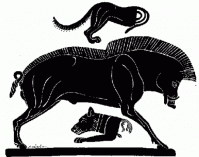
Because of their force, courage, and ferocity, the wild boar symbolized a worthy antagonist for the hunter as well. Theseus determined to slay the Krommyon boar to prove his bravery by risking his life in battle against this formidable opponent. The fourth of the labours of Herakles involved the pursuit and capture of the Erymanthian boar. Odysseus managed to overcome his beastly foe but not earlier its tusks left their mark on his body. Unfortunately, the ferocity of the boar hunted past Adonis led to his decease. The Greek farmer or warrior hunted the wild boar to protect crops or for sport. The hunter might dedicate the tusks of the boar, killed in dangerous circumstances, in a sanctuary or mount its tusks upon a battle headdress.
Artists of the Archaic period of Greek art were attracted to the muscular build, pliant pare, bristly mane, and fierce countenance of the wild boar. Its paradigm appeared oftentimes on coins, gems, vases, and reliefs.
- Bevan, Elinor. Representations of Animals in Sanctuaries of Artemis and Other Olympian Deities. Oxford: B.A.R., 1986.
- Comstock, Mary and Cornelius Vermeule. Greek, Etruscan, & Roman Bronzes in the Museum of Fine Arts, Boston. Greenwich, Connecticut: New York Graphic Society, 1971.
- Hall, James. Dictionary of Subjects and Symbols in Art. London: John Murray, 1974.
- Morin, Jean. Le Dessin des Animaux en Grece d'apres les Vases Peints. Paris: Librairie Renouard, 1911.
- Rawson, Jessica (ed.). Animals in Art. London: British Museum Publications Limited, 1977.
- Richter, Gisela. Animals in Greek Sculpture: A Survey. New York: Oxford University Press, 1930.





These depictions of wild boars, taken from Archaic vases, display the artists' interest in their strong build and the decorative possibilities of the mane, tail, and fur. During the Hellenistic period artists concentrated on portraying people and animals naturalistically as shown in these gems. The fierceness of the boar and the dangers of hunting information technology remain a constant chemical element.
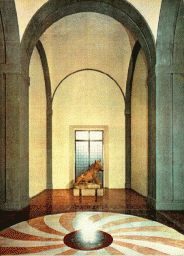
This marble statue of a wild boar (from which UWaterloo's casting was taken) is rendered in a completely naturalistic style characteristic of the Hellenistic catamenia. It sits in the Uffizi, Florence.
Top of folio
Roman World
The large, tusked wild boar (cinghiale) was found in affluence in almost every country of the aboriginal Roman world and peculiarly so in Italian republic. Wealthy Roman gentry often established private parks, called vivaria, in which boars were kept. These partially tamed animals were sometimes trained to come running when their keeper, dressed as Orpheus, whose renowned musical ability with the lyre enabled him to amuse wild beasts, announced their mealtime. Manifestly, these antics gave pleasure and amusement to their owners. The proximity of the boars also allowed owners to serve an exotic meat to guests on special occasions. Some other reason for keeping boars in vivaria was for the sport of hunting, primarily for its own sake, and secondarily for provisioning the table in a more exciting manner than direct slaughtering. Wild boars likewise made appearances at spectacles in Rome, tamed for display or equally role of a procession, or wild and battling each other or other animals. Animals in Roman fine art look back to Greek or Hellenistic models, and information technology is hard to notice how far they reflect a genuine Roman sensibility. Nonetheless, images of boars, lonely or equally office of a hunting scene, have been discovered decorating a wide range of objects.
- Bevan, Elinor. Representations of Animals in Sanctuaries of Artemis and Other Olympian Deities. Oxford: B.A.R., 1986.
- Clark, Kenneth. Animals and Men: Their Relationship as Reflected in Western Art from Prehistory to the Present Mean solar day. London: Thames and Hudson, 1977.
- Toynbee, J.M.C. Animals in Roman Life and Art. London: Thames and Hudson, 1973.
- Ward Perkins, John and Amanda Claridge. Pompeii Advertizing 79. Bristol: Imperial Tobacco Limited, 1976. Wilson, R.J.South. Wilson. Piazza Armerina. Austin, Texas: University of Texas Printing, 1983.
Top of page
Renaissance Period
The Renaissance signalled a period of rediscovery. Greco Roman statues were profoundly admired along with the legends that inspired them. The city of Florence became the intellectual and artistic capital of southern Europe for a century, starting time in the early fifteenth century. Information technology took for its model the ancient Roman republic and its populace were urged to identify themselves with its spirit. In fine art, a new realism emerged based on the study of humanity and natural forms and coupled with the idealism of Classical forms.
Around 1620 a Florentine sculptor by the proper noun of Pietro Tacca (1577-1640) made a bronze casting from the marble boar, Cinghiale, now in the Uffizi (come across the photograph to a higher place). Tacca began his career in 1592 when he became an apprentice in the studio of the renowned Renaissance sculptor, Giovanni Bologna. The industry and international export of pocket-sized bronze statues were staple products of the workshop. Here Tacca was trained in the techniques of marble sculpture, bronze sculpture, and statuary casting. His talent and technical skill soon propelled him into the office of Bologna's principal assistant. Upon Bologna's death in 1608, Tacca became Workshop Manager and court sculptor. In this capacity, his claim to fame is his equestrian statues of the Chiliad Duke Ferdinando I of Tuscany, Henry IV of France, and Philip III of Kingdom of spain. Tacca, every bit court sculptor, was forced to undertake smaller commissions also. For the wedding of Prince Cosimo in 1608 he executed eight bronze turtles for the bases of the obelisks in Piazza Santa Maria Novella. Maria de Medici ordered him to create statues and groups of figures in carbohydrate as table decorations for her wedding ceremony banquet. Amid these statuettes were the labours of Hercules, hunting scenes, and groups of figures such equally cupids, centaurs, monsters, animals, and fountains.
Tacca was best known for his technical brilliance and his refining of the casting procedure. Unfortunately, his fame did non his fortune make every bit he constantly complained about not getting paid for piece of work completed. In addition, his health suffered. As a master founder he closely supervised every stride of the casting process to the point of endangering his physical safety and wellness for a lifetime. The casting of a bronze sculpture involves the pouring of molten metallic. This process could take place whatsoever time, but since the dry months of tardily summer and early autumn were preferred for the drying of the cadre or plaster models and molds, this meant that the casting normally took place in the winter or spring. These were the coldest and dampest seasons in Florence. As well, the Borgo Pinti studio was situated in one of the lowest parts of the city, facing a narrow, night street and backed upon open fields. Scholars have speculated that Tacca must accept been truly miserable as he faced the boiling temperatures of the casting furnace in a cold and boiling foundry.
- Pyke, East. J. A Biographical Dictionary of Wax Modellers. Oxford: Clarendon Press, 1973.
- Watson, Katharine. Pietro Tacca: Successor to Giovanni Bologna. New York: Garland Publishing, Inc., 1983.
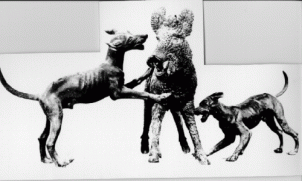 Tacca's recasting of the Greco-Roman Cinghiale may accept been influenced by this slice. The group, which derives from Hellenistic fauna sculpture, originally stood betwixt bronze figures of a snake, a deer, and a king of beasts on the semi-circular fountain basin in the middle of a peristyle. H2o gushed in to the puddle from two sources: a pipe in the boar's mouth and from the mouth of the hound on the correct, which is trying to bite the boar'southward leg. The front paws of the hound on the left were fixed to the side of the boar by rivets. Tails and ears were bandage separately.
Tacca's recasting of the Greco-Roman Cinghiale may accept been influenced by this slice. The group, which derives from Hellenistic fauna sculpture, originally stood betwixt bronze figures of a snake, a deer, and a king of beasts on the semi-circular fountain basin in the middle of a peristyle. H2o gushed in to the puddle from two sources: a pipe in the boar's mouth and from the mouth of the hound on the correct, which is trying to bite the boar'southward leg. The front paws of the hound on the left were fixed to the side of the boar by rivets. Tails and ears were bandage separately.
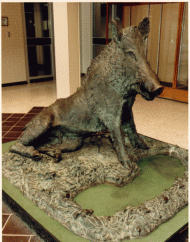
In 1962, v copies of Tacca'due south sculpture were cast by the Florence foundry, Fonderia Ferdinando Marinelli. Thanks to the generosity of Dr. Henry Crapo 1 of these was donated to the University of Waterloo in 1978. The four other copies of the boar are located in Sydney, Australia; California; Florence; and in Butchart Gardens, Victoria, B.C.
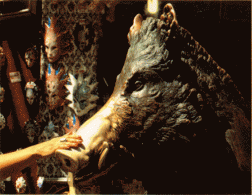
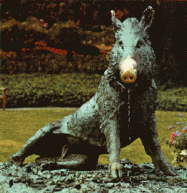
<< Return to Contents The Boar in the News >>
<< Return to Exhibits
Source: https://uwaterloo.ca/library/special-collections-archives/exhibits/celebrating-boar/boar-art-history
Posted by: spatesbrin1959.blogspot.com

0 Response to "Is The Boar A Sacred Animal Of Mars"
Post a Comment